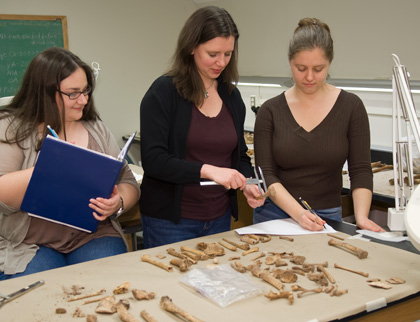Trickle-Down Effect
August 21, 2012
Related:
From Maxwell Perspective...
Trickle-Down Effect
As happens in every graduate program at Maxwell, projects such as Spring Street Presbyterian help establish student careers.

Doctoral students Katie Hicks, Meredith Ellis, and Lauren Hosek (from left), examining Spring Street remains
Along with Shannon Novak's work on the Spring Street church vaults, many students have found rich material in the collection for their research.
Several Honors Program undergraduates have done capstone projects related to the church. Plus, two anthropology dissertations are in progress; Meredith Ellis is researching the lives of the children of Spring Street, and Katie Hicks is analyzing metal artifacts (such as coffin plates) and transcribing names obscured by corrosion and decay. In addition, Lauren Hosek, preparing for PhD work on a different topic, used the Spring Street project to develop laboratory skills.
Ellis was teaching literature and writing courses at area colleges back when the Spring Street materials arrived. Out of curiosity, she volunteered to help Novak in the lab with sorting and cleaning bones, but was quickly hooked and decided to pursue a PhD in anthropology.
She has spent time at the Presbyterian Historical Society (in Philadelphia) and the New York State Historical Association, reconstructing the setting of the church and lives of the congregants. "The ability to leave these archival sources," says Ellis, "and then directly see, touch, and learn about the congregants from their remains is a remarkable intersection of history and archaeology.
"Even more amazing is that this collection is here at Syracuse. Most students in my department travel around the world to get access to sites or collections. I walk two miles from my house to the lab, and my world of research is waiting for me."
— Jeffrey Pepper Rodgers